
 |
 |
|
I have always been fascinated by volcanos. Ecuador is blessed with a number of snow-capped volcanos and whenever I am anywhere I always look around to see which ones are out. I never get tired of their beauty. This is due in part to the fact that Ecuadorian volcanos seem to enjoy playing a game of hide and seek. There are several that always seem to be hiding whenever I am traveling past them. Tungurahua (16,452 ft) is one that has eluded me often. In the 6 years I've been in Ecuador and the dozens of times I've driven past it, I've only seen it clearly 5 times. |
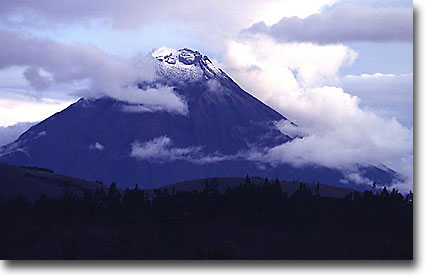 |
 |
I've been on four trips to specifically photograph Tungurahua since it began erupting several months ago. The first two were pretty disastrous. Tungurahua sits on the eastern edge of the Andes Mountains and the prevailing winds push clouds up the Pastaza river valley over the now evacuated town of Baņos towards Tungurahua. At the same time clouds move north-east along the highlands from Riobamba and seem to stop once they get to Tungurahua. If it isn't cloudy, it is foggy. Of course either one covers everything with mist and it also rains a lot. |
|
I find that I often get the best opportunities to photograph Ecuador's volcanos when I least expect it. About a month ago I went down to the town of Latacunga to photograph the "Mama Negra" festival. (A future feature on this site.) I was leaving for Quito not really thinking about Tungurahua as I had been lugging my cameras around for some 6 hours. Besides that Tungurahua is about another hour or so south. I had driven for about 5 minutes when I looked back in my rearview mirror and saw Tungurahua.
|
 |
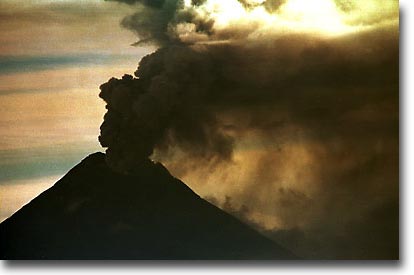 |
I quickly realized that this was too good of an opportunity to pass up, so I turned around and headed south looking for foregrounds free of powerlines that would work well.
I had traveled a half-hour or so and had stopped several times without much luck. Just as I had stopped again, I noticed that a large pillar of ash was shooting straight up. I ran up a small hill and began shooting. To my horror however I discovered that I only had about 12 frames of slide film left. Fortunately I had 4 rolls left of print film. Unfortunately I had left my tripod and jacket at home to avoid theft, so I was limited as to what I could shoot and staying the night was out of the question. I shot till it was dark and went home. |
|
If you really want to experience Tungurahua in all of her glory, you have to spend the night.
It does get rather cold though and I was still sore thinking about sleeping in the very cramped back of a friends car (pictured above). But persistance is the key to good photography so I traveled down again with a friend hoping I'd be able to get something on film. When we arrived we could vaguely see part of the volcano, but it was getting cloudier and it was not looking good. As an eternal optimist, I kept telling my friend that I thought it was beginning to clear. This had not worked before but a glimpse of hope is a more pleasant way to start a long night. It was getting dark and we couldn't see much past my tripods, but we heard Tungurahua rumble. |
 |
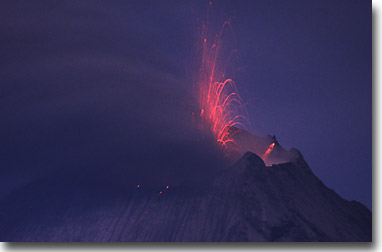 |
Well actually, I thought it was the dump trucks used to haul chicken feed below at Cotalo. We would hear the sound again later that night. I was frustrated that I hadn't been able to get my 7 cameras lined up and set for the night. I was worried that our 8 hours of driving time was wasted and was really not looking forward to another a long cold night in the car. All of the sudden we looked out and realized that the mountain was out and we could see the outline of other mountains as well. I hopped out and quickly got everything lined up the best I could. That night we were rewarded with a dozen or so eruptions of glowing rocks. We heard Tungurahua roar for nearly 15 minutes as if it were a Jet taking off. |
|
By 1:30 we were both pretty cold and ready to go to sleep. Murphy's law say the best pictures are the ones that happen after you've put your camera away and of course Murphy's law struck not even 5 minutes after I had crawled into my sleeping bag. But the moon was out and we could the nearby snow-capped volcano Altar. We could hardly sleep as we kept wanting to see one more explosion. I set my watch alarm hoping I might see some more before the sun came up. We were treated to a relatively clear morning and all of the mountains were out. Unfortunately we had both promised our wives that we would be home for Thanksgiving dinner, so we didn't have much time to stop along the way back. |
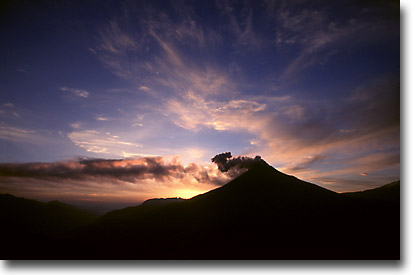 |
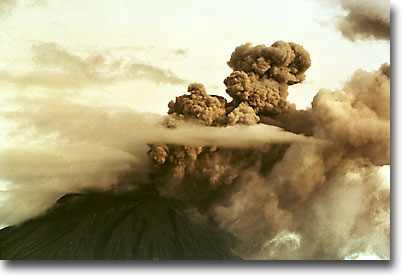 |
My last trip to Tungurahua started off looking promising as we could see clouds of ash spewing out of the cone when we arrived. But it kept disappearing from view. Around 9:30 p.m. it cleared for about 5 minutes. We could see all of the stars that God created above us with incredible glory, the clouds were below us in the valley and Tungurahua was roaring and erupting clouds of ash. And as quickly as it had cleared, the clouds rolled up the hill and it was gone. I did not take a single image that night. It is these fleeting moments of beauty that I enjoy most and perhaps one of the reasons I will enjoy going back to Tungurahua the next chance I get. |